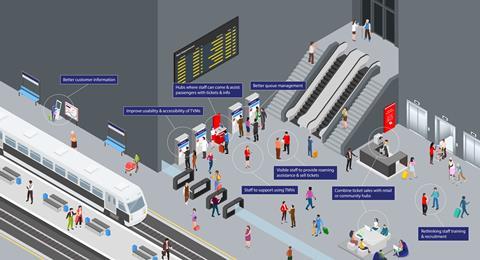If the proposed closure of station ticket offices in England is not purely about cost-cutting, then carefully considered customer-centric interventions will be needed to make it work, argues David Watts, Managing Director of human-centred design agency Mima.

UK: Proposals to close the majority of station ticket offices in England are controversial, and worrying for a significant number of passengers who continue to rely on them.
While the majority of tickets are now sold at self-service machines, online or through contactless payment, around 12% of tickets are still purchased at staffed offices. This is a minority but, when considering that 1·4 billion passenger-journeys were made in Great Britain in the last year, still represents a significant number of transactions.
At Mima we believe it is possible to make changes while still delivering a good customer experience — but it has to be done in the right way. Some reductions in costs and headcount may result, but this cannot be the real target.
If the real intention is simply to increase the number of stations that are unstaffed, then this is almost guaranteed to negatively impact the passenger experience. However, Rail Minister Huw Merriman has publicly said that no currently staffed stations will be left unstaffed as a result of these reforms.
The key question remains, what are we trying to trying to achieve? Are we modernising the service, or taking a backward step and trying to cut costs? The Department for Transport has insisted it is not the latter, although this view has been greeted with some scepticism, especially by the railway trade unions.
Nevertheless, it is pertinent to ask what these ticketing changes might look like if the aim were to actually improve the service for passengers?
Places that are human

We need stations to continue to be places that are human and where people are at the centre of delivering a service, even if this is supported by digital interactions.
It is highly likely that the approach to ticket sales will vary across station types and routes. It might be that there should be some degree of commonality, especially on one line, but some variation is likely. So the key will be how operators can provide passengers with information on what is available at their stations.
This means that communication around the changes and what will be in place at each station is critical, particularly for people who need assistance to be able to prepare for their journey.
We need visible staff that can provide mobility assistance, offer advice and sell tickets. They might be roaming, and so they will need to be clearly identified and appear approachable with more visible uniforms; examples of this can be found in airport management and retail.
We need recognisable ‘anchor points’ where staff are based, with a way for people to summon staff when they need them, as passenger could on an aircraft. Staff need to have tools and equipment to advise passengers and sell tickets.
The perceived shift to ticket vending machines being the sole means of buying tickets at stations is a significant cause of concern for many passengers. Current TVM designs are often not optimised for usability and accessibility, and need to be improved quickly. They also have reliability issues, so operators and the regulator will need to consider what happens when they are broken.
In some larger stations a flexible ticketing approach could be implemented, with TVMs providing the primary sales channel and trained staff based at compact ‘ticketing hubs’ interspersed in the line of TVMs. These hubs would have a compact but fully functioning ticketing system for staff to facilitate sales and print tickets, with an aim of helping passengers who may need extra assistance. These hubs could also provide reassurance and a high level of service for transactions that cannot be easily undertaken at TVMs, such as advance purchase ticket sales, season tickets, multi-ticket trips, refunds and (if necessary) cycle tickets. There are already examples of this offering being rolled out today — Mima was part of the team that has developed a hybrid ticketing approach for Gatwick Airport station.
In larger stations with more TVMs and roaming staff, queue management systems need to be rethought. At some stations there may be opportunities to increase efficiencies by combining ticket sales with other retail facilities, as Merseyrail has done for the past several years with its ‘MtoGo’ service delivering ticket retail in convenience stores.
The proposals mean changes for staff, and will require a different approach to future recruitment. There is also an issue with how staff get a rest from being ‘front of house’ and on their feet all the time. Rosters and station furniture will have to be redesigned.
Ticket offices are also a source of information, and operators will need to rethink how and where this will be provided. This is an opportunity in bringing the holder of the information — the member of staff — out from behind a desk. However, we would be losing the certainty and clarity of where this person is located, and so a new service design is going to be required.
None of this can happen overnight, and immediately closing ticket offices and removing staff would reduce the quality of service and experience. But if the rollout of closures happens alongside a programme that addresses the challenges outlined here, then the overall customer experience could still be positive.
Longer-term considerations
There are also some more long-term considerations that can build on the changes to continue improvements:
Closing ticket offices creates a new space that can be repurposed with wider benefit to passengers and the local community. This connects with a wider agenda about opening up the station to the community and providing other socially valuable local services, such as linking rail travel with tourism opportunities.
There are potentially better ways to sell and validate tickets than we see on trains at the moment. So let’s rethink the ticket, lose the gateline, maybe even lose the phone as well as the paper.
We also need to ask if there might be an upside for some communities: could efficiencies that reduce staffing requirements at some larger stations allow for redeployment to smaller ones that are currently unstaffed? If the process were focused on redesign rather than removal, and done so with passengers, staff and their varying requirements and preferences at its heart, this could be a good news story.
Closing ticket offices under the latest proposals would have significant implications for the experience of many passengers, especially those who rely on human interaction and assistance. If cost-cutting is not driving the change, then a supported experience can still be delivered. However, this needs careful consideration and the design and execution of a number of important interventions to make it work.


David Watts is Managing Director of Mima — www.mimagroup.com —- a human-centred design agency with over 40 years’ heritage in blending insight into human behaviour with design thinking.
The multi-disciplinary practice brings together human factors, accessible and inclusive design, wayfinding and information design, user research & behavioural science with service and experience design, immersive technology and workspace design. Its clients include Network Rail, the National Health Service, Dubai Expo 2020, Reliance Industries, Heathrow Airport, Science Museum Group, Transport for London, Jaguar Land Rover, CERN, Royal Museums Greenwich, Guide Dogs for the Blind, Ambassador Theatre Group, Dublin Airport and Equinor.



